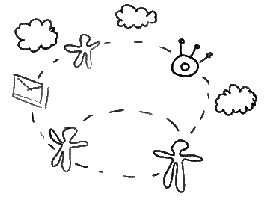Objective
3: People's Experience
As
described in the previous two objectives, collections of artefacts
represent a ‘radical distribution’ of computing and information
processing that can inter-work to deliver new functionality and
lead to new patterns of behaviour.

It
is the integration of these concepts with real-world settings and
with real objects, that offers opportunities for new ways of supporting
people’ s everyday activities - ways that go above and
beyond what the personal computer (pc) can offer today.
In
this respect, one can imagine groupings of artefacts could substitute
some of the functions that the pc can perform today, however in
a more distributed fashion and based a more natural form of interaction.In
other cases, one can imagine groupings of artefacts designed to
take advantage of the new context and support people’s activities
in a completely different ways.
It
is therefore necessary to address ways in which people’s activities
can be supported or enhanced in such new environments. The basis
for this is to consider how to design artefacts or how to design
for collections of them. Furthermore it is important to see how
they can lead to coherent experience in real world settings and
how people can participate in them.
 Designing
and Prototyping Artefacts Designing
and Prototyping Artefacts
The
nature of information artefacts, as described in
objective
1 and objective 2,pose a number
of challengesas regards how artefacts should be designed. This includes
for example:
- How
to design an individual artefact, and how to integrate utility
design with software/hardware constraints.
- The
design of the functionality of an individual artefact and how
this can be combined with that of others.
- Research
on how to design for collections of interacting artefacts and
how to design in the context of a collective and emerging functionality.
- The
use of iterative prototyping and new evaluation methods.
Coherence
A
world full of interacting artefacts could easily confuse people.
Research is needed in order to make sure that environments are coherent
and understandable. This could include for example:
- Ways
to integrate artefacts with real places and locations.
- The
use of metaphors, cognitive or semantic models, to guide the design
of environments.
- Approaches
that ensure ‘seamless interaction’, for example, for
an activity that takes place across different locations and different
stages in time.
Engagement
 In
contrast to concentrated engagement in one location (as with a pc),
the distributed nature of a collection of artefacts in real locations
leads to a range of research issues on how to support people’s
activities in this context, for example: In
contrast to concentrated engagement in one location (as with a pc),
the distributed nature of a collection of artefacts in real locations
leads to a range of research issues on how to support people’s
activities in this context, for example:
- The
ways in which both individuals and groups of people can participate
in such environments.
- The
design of engagement that is appropriate to an activity. This
includes active engagement that requires concentration, through
to relaxed participation that is ‘laid-back’, enjoyable
or fun.
- The
ways in which sequences of interaction and experience can be structured.
For example, the use of ‘interactive narratives’, that
can guide or engage people in space and time, and the ways in
which such narratives can encompass pre-scripted elements as well
as emergent, or unexpected events.
|